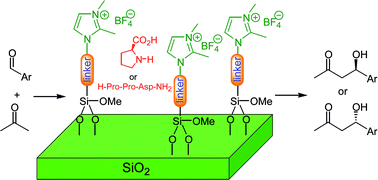New ionic liquid-modified silica gels as recyclable materials for l-proline- or H–Pro–Pro–Asp–NH2-catalyzed aldol reaction
Abstract
L-proline and the tripeptide H–Pro–Pro–Asp–NH2 (1) have been supported, by adsorption, onto the surface of modified silica gels functionalized with a monolayer of covalently attached 1,2-dimethyl-imidazolium chloride, tetrafluoroborate or hexafluorophosphate ionic moieties, respectively. Three different linkers were used to attach the ionic liquid moiety to the surface of these supports. The resulting materials have been used as catalysts for the aldol reaction between acetone and several substituted benzaldehydes. Good yields and enantioselectivities, comparable to or better than those obtained under homogeneous conditions, were obtained. These materials are easily recovered by filtration, and studies regarding their re-use have been carried out. Studies performed using L-proline-supported materials have shown that the re-use of these materials is dependent on the nature of the linker. The supported tripeptide H–Pro–Pro–Asp–NH2 gave higher enantioselectivities than those obtained with supported-proline. Recycling investigations using tripeptide-supported materials showed continued good selectivities but diminishing conversions over consecutive runs. L-proline-supported materials however, can be used at least nine times without loss of either conversion or selectivity.


 Please wait while we load your content...
Please wait while we load your content...